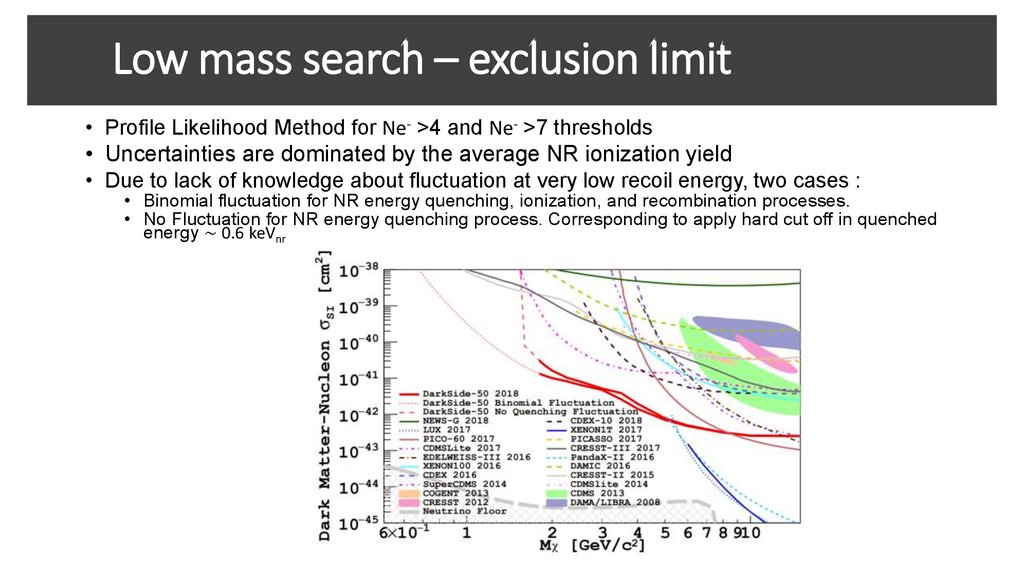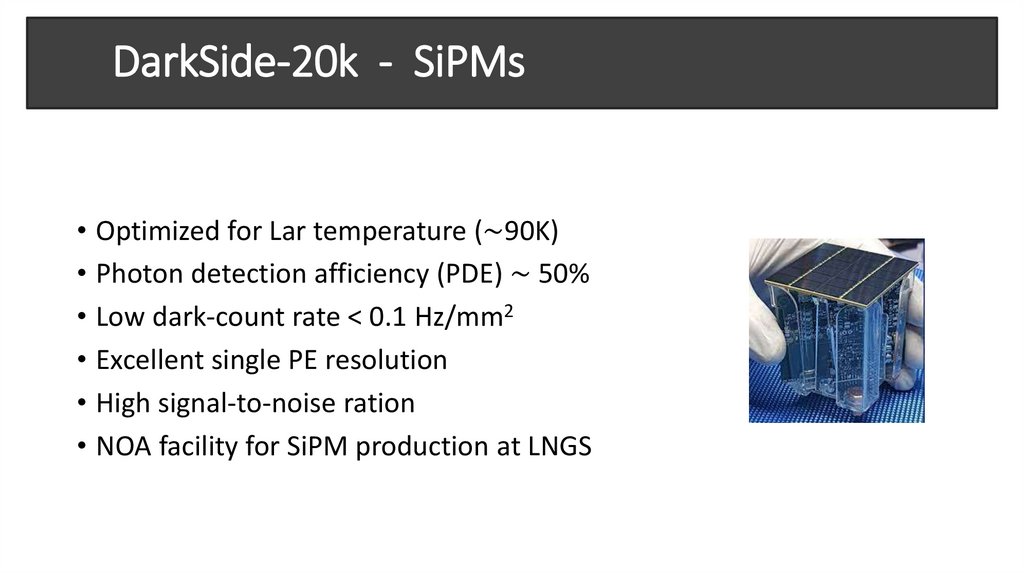Similar presentations:
The DarkSide experiment
1.
The DarkSideexperiment
2. Searches for Dark Matter
3. The DarkSide-50 detector
Dual Phase TPCLar TPC
• Cylindrical cryostat
• Lar target and 38 PMTs
• Transparent silica cathode and
anode coated by Indium Tin Oxide
(ITO)
• Drift field 200 V/cm,
extraction field 2.8 kV/cm,
electroluminescence field 4.2 kV/cm
Liquid Scintillator detector
• Stainless steel sphere
• 30t of 10B-loaded liquid scintillator
Water Cherenkov detector
• Stainless steel cylinder
• 1kt of ultra-pure water
4. Underground Argon (UAr) in DS-50
Run1 with AAr• 39Ar is produced by cosmic rays in
the atmosphere. It undergoes βdecay with Q= 565 keV, τ½=269 yr
activity ~1 Bq/kg → limiting
the performance of the detector
39Ar
Solution: extract Argon from underground
(in Colorado)
Run2 with UAr
39Ar
activity (0.73 ± 0.10) mBq/kg
• factor ~1400 in 39Ar depletion
5. Dual-phase TPC: working principle
• Light collected by top and bottom PMTarrays
• S1: primary scintillation
• produced in Lar
• due to excitation and
recombination after ionization
• S2: secondary scintillation
• produced in Ar gas
• by electrons escaped from
recombination
• Drift time →vertical (z) position
• S2 light pattern →position in xy plane
6. Scintillation in LAr
• The recoil produce ionization Ar+ and excitation Ar*EXCITATION
Ar* + Ar →Ar2*
Ar2* → 2Ar + hν
IONIZATION
Ar+ + Ar → Ar2+
Ar2+ + e → Ar** +Ar
Ar** → Ar* + heat
Ar*+ Ar →Ar2*
Ar2* →2Ar + hν
• Excited dimer Ar2* emits light in singlet or triplet state
• Two scintillation time constants
• Singlet ~7 ns
• Triplet ~ 1500 ns
7. Pulse Shape Discrimination (PSD)
• To discriminate between nuclear recoil (NR) and electron recoil (ER)• Nuclear and electron recoils have different ratios of singlet and
triplet excimer states
• Discrimination is possible between NR and ER
• PSD parameter: f90
S1 light in first 90 ns
f90 =
total S1 light
f90 ~ 0.7 for NR
f90 ~ 0.3 for ER
8. Electron Recoil rejection
Rejection of ER bagkground is based on• PDS (> 107)
• Ionization/Scintillation S2/S1 ( ~103)
9. Active Rejection
ER rejection: PSD + S2/S1Surface events:
fiducialization
Active Rejection
Anticoincidence
10. WIMP search region
WIMP search region:• < 0.1 total background events
• maximal NR acceptance
AAr
Compute
• ER leakage curves:
high statistic AAr dataset dominated by 39Ar ER
events
• NR acceptance contours
• SCENE experiment
• In situ calibration data with AmBe neutron
source
UAr
11. Blind analysis and results
Results:Run1 with Aar
• Exposure (1422 ± 67) kg d
• PSD suppress 1.5 × 107 events of 39Ar background
• 90% CL upper limit σ = 6.1 10-44 cm2 for 100 GeV/c2
Run2 with Uar (2018)
• Exposure (16 660 ± 270) kg d
• 90% CL upper limit σ = 1.14 10-44 cm2 for 100 GeV/c2
e.g. Blind box for run2 with UAr: solid red line
run2 with UAr (2018)
12. Low mass searches: S2 only
• WIMP mass range < 20 GeV/c2• Lower detection threshold down to Ne- = 4 (<
0.1 keVee)
• 100% trigger efficiency at Ne- = 1.3
• Use only S2 signal
• No PSD
• No vertical fiducialization
• Model fit agrees with data where Ne- > 7
• Excess of data in the region [4 Ne- , 7 Ne- ], the
origin is left for future studies
• Two signal regions
• a) above 4 Ne• b) above 7 Ne-
• 90% CL exclusion curves
13. DarkSide-20k
GOAL:Lar TPC
Veto detector
• 49.7 t of UAr (URANIA and ARIA)
• GD-doped acrylic shell
• Silicon PhotoMultipliers (SiPMs)
• SiPMs
• 300 t of AAr
• background-free exposure
• Sensitivity of σ = 7.4 10-48 cm2 for 1 TeV/c2
• With 200 t yr exposure
Projected sensitivity
Copper Faraday cage
• Optical insulation
• Filled with AAr
Proto-DUNE-like cryostat
• 750 t AAr
14. DarkSide-20k
Key features:• Extraction and purification of lowradioactive UAr
• Large-scale production of SiPM for light
detection in TPC and veto
• Design enable to separate the
cryogenic systems and UAr volume
• New TPC technologies, e.g. acrylic
vessels
• Active n-veto with AAr and GD-doped
plastic
←Extraction by
URANIA facility
(Colorado)
→Purification by
ARIA facility (Italy)
Photodetection Module (PDM):
SiPM tile + front-board electronics
15. DarkSide-Proto
Prototype detector of intermediate size ~ 1tThree separate phases
• Proto-0: test of cryogenic system + preparation of
full readout
• Proto-1: assembly and test of LArTPC with 50 PDMs
• Proto-2: assembly and test of full LAr TPC system
16. Argo detector
• Step afterDarkSide-20k
• Total exposure of
3000 t yr
• Fiducial mass of ~
300 t
17.
Conclusions• Dual-phase Ar TPC are a proven and competitive technology for
WIMP searches (DarkSide-50)
• A joint collaboration is proceeding for the realization of DarkSide-20k
• Consistent research program projected for the future
18.
19. Dual phase TPC
S1:• Yield 7.0 PE/keV at 200 V/cm
• integration window of 7 µs
S2:
• Yield 23.0 PE/e• integration window of 30 µs
Electron life-time > 50 ms
Maximum drift time 376 µs
20. ER calibration
External calibration:A robotic arm deploys γ and n
sources:
• 57Co (E=122, 136 keV)
• 137Cs (E= 662 keV)
• 133Ba (E= 81, 356, 383 keV)
• AmBe (neutrons + γ)
Internal calibration:
83mKr injected into the Ar flow to
study
• Scintillation light yield
• z-dependence of light collection
• S2/S1 yield
S1 spectrum of
83mKr and 39Ar
at null field
21.
NR calibration• SCENE and ARIS experiments: small Lar TPC exposed to n beam
• To calibrate S1 and S2 response for NR
• In situ calibration with AmBe-AmC n-source
22. ER background
PSD is a powerfull technique• demonstrated in Run1 with AAr: suppression for 39Ar > 107
• with a MC simulation (DEAP-3600): achievable discrimination of ER > 109
The most difficult ER background
• Multiple scatters of γ-ray → fiducialization + require sigle-scatter event
• Cherenkov events → specific cut analysis (S1 too concentrated in 1 PMT) + S2/S1
23. NR background
NeutronsBackground rejection:
• TPC: multi-scatter
• LSV: 99% efficiency (determined
with AmC data)
• WCV (for cosmogenic n)
Alpha’s
Background rejection:
• Typically high S1 (out the ROI), but a
small fraction at low energy (degraded
energy event)
• Fiducialization
• Reject events with
• small or no S2
• Long scintillation tail from TPB
fluorescence
24. Background
WIMP signal• rare: expected rate ~ 10-4 evt/(kg d) for mχ=100
GeV/c2, σχN= 10-45 cm2
• Consists in ~10 keV energy deposit
Background
• ER:
39Ar
~9
104
evt/(kg d)
→ inner volume events: PSD + argon
depletion
γ ~ 1 102 evt/(kg d)
• NR μ ~ 10-4 evt/(kg d)
radiogenic n ~ 6 10 -4 evt/(kg d) → U, Th decay chains: material
α ~ 10 evt/(m2 d) → Surface events: fiducial xy
cut and Rn suppression
• ν
ν-electron scattering
CNNS
→irreducible NR
→ reducible ER: PSD
purity
25. Low mass search - ER calibration
• S1 signal threshold at ~ 2 keVee(~ 6keVnr): weak sensitivity to low mass
• S2 signal threshold ~ 0.1 keVee (~ 0.4
keVnr)
• Detection efficiency estimated from
Data +MC
• Fiducialization: largest signal must be
recorded in one of the 7 central PMTs
• Possible to detect down to single
electron
• For Ne- = 1 (23 ± 1) PE are produced
26. Low mass search - ER calibration
• Calibration of ER energy scale down to 270 eV• with 37Ar (τ1/2~ 35 d): E = 0.27 keV, E = 2.8 keV
• with first 100 days UAr dataset
27. Low mass search - NR calibration
• In situ: from AmBe and AmC sourcesExternal: from ARIS and SCENE experiments
• Using MC template fit to DS-50 AmBe and AmC n-spectra data
• Uncertainty (red band) from deviations wrt external n-calibrations
(ARIS, SCENE)
28. Low mass search – exclusion limit
• Profile Likelihood Method for Ne- >4 and Ne- >7 thresholds• Uncertainties are dominated by the average NR ionization yield
• Due to lack of knowledge about fluctuation at very low recoil energy, two cases :
• Binomial fluctuation for NR energy quenching, ionization, and recombination processes.
• No Fluctuation for NR energy quenching process. Corresponding to apply hard cut off in quenched
energy ∼ 0.6 keVnr
29. Low mass search – sub-GeV
• search for light dark matter:interaction through a vector mediator
with couplings weaker than weak
scale
• analysis threshold Ne- =3 (~0.05
keVee)
30. DarkSide-20k - SiPMs
• Optimized for Lar temperature (~90K)• Photon detection afficiency (PDE) ~ 50%
• Low dark-count rate < 0.1 Hz/mm2
• Excellent single PE resolution
• High signal-to-noise ration
• NOA facility for SiPM production at LNGS
31. DarkSide-20k - PSD
• In DS-50, f90 was the PSD parameter• In DS-20k, the PSD performance was simulated using
four different parameters: f90, f120, f150, f200
• Simulation is tuned to DS-50 data and to measured DS20k readout characteristics, including SiPM PDE and
noise rate
• In DS-20k, f200 parameter is favoured
• Expected suppression of 39Ar > 3 109































 physics
physics
